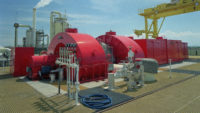Inspired by the success of the project delivery approach for infrastructure for the 2012 Olympics Summer Games in London that came in on time, under budget and without any deaths, procurement staffers at the National Renewable Energy Laboratory decided to apply a new idea of their own.
The needs of the Golden, Colo.-based U.S. Dept. of Energy research agency are significantly different from those of the $10-billion global sports event that attracted thousands of participants and attendees. But Brittany Decker, NREL director of acquisition services, says its contracting experts saw commonalities with the Olympics project's complexity and its goals relating to safety, sustainability and partnership.
“It sort of touched on all of the things that NREL cares about,” she told ENR.
After pitching the idea to DOE officials, lab staff worked with them to craft a way they could implement the model. They called the result the “cooperative construction contracting approach,” or CCCA.
NREL awarded its first contract under the approach last month to a design-build team of JE Dunn Construction Co. and SmithGroup.
The delivery method builds on an earlier performance-based design-build approach NREL had piloted and evolved over time, says Bret Cummock, who heads its capital investment program. With the new approach, the agency aims to scale up contracts to cover multiple projects and accelerate their timing while also leveraging knowledge the contractor gains over the course of the work.
Each year, contractor staffers "are working with us, they know us better and better,” Cummock says. “They understand our safety culture, our partnering culture, what we want and what we prioritize as a lab.”
The approach is intended to be more than just a single-source indefinite delivery/indefinite quantity contract, Decker says. The contractor would be a collaborative partner on NREL’s project planning team.
“We don’t pre-engineer the building, we truly give it to our partner to ... come up with unique, innovative design solutions for our research needs,” she says. “That enables us to really embrace this idea of partnership and move away from the more traditional sort of oversight role.”
The CCCA prime contractor is also required to have mentor-protege agreements with at least two small businesses. Decker says NREL hopes it can develop relationships with those smaller contractors for work not large enough to qualify under a prime contract.
NREL research facility projects often rely on electrical or mechanical equipment with longer lead times—between one and three years in some cases, according to Cummock. By partnering with one contractor on a portfolio of work, the agency aims to keep contractors working on other task orders, cut demobilization and remobilization costs and deliver multiple projects more efficiently within a compressed time frame.
To attract large, experienced prime contractors, NREL plans to include a “flagship project” in each contract. For the first one, that flagship is the $224-million Energy Materials and Processing at Scale facility at the lab's Golden campus. The contract has a five-year, $500-million ceiling, records show.
Decker says NREL staffers were overall “elated” by the contractors that submitted for the contract, although she acknowledges the new form of project delivery may have been “scary to some of our companies” and reduced the number of bidders.
“Hopefully, by proving that CCCA can be successful and effective, we can change that in the future,” she says.






Post a comment to this article
Report Abusive Comment